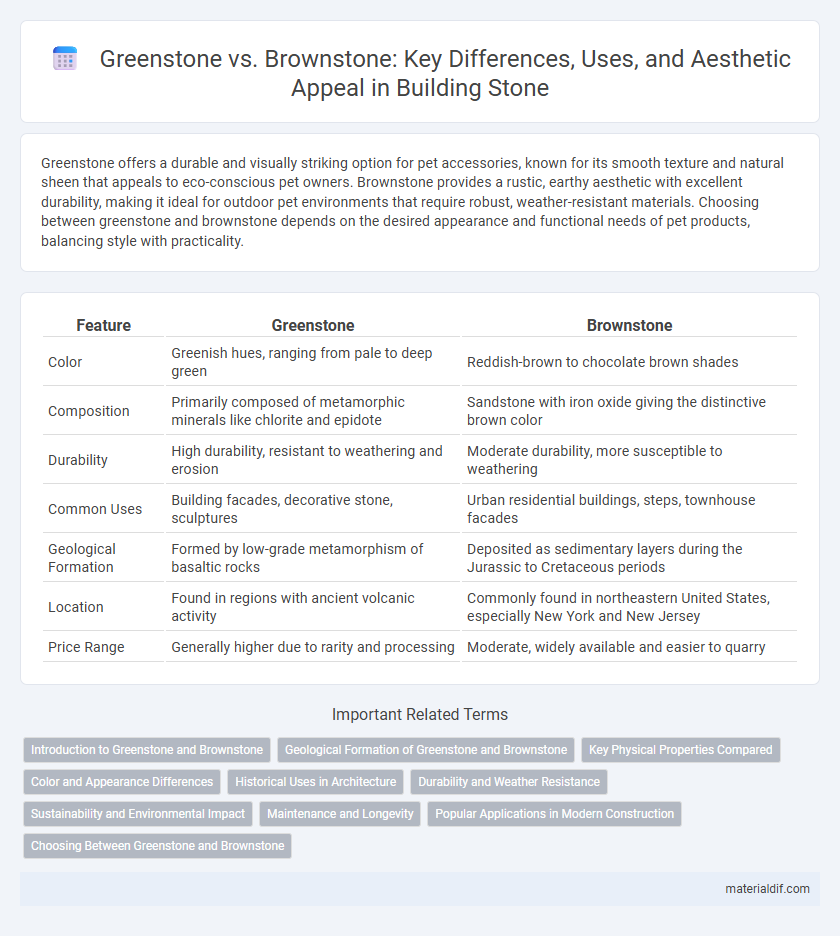Greenstone offers a durable and visually striking option for pet accessories, known for its smooth texture and natural sheen that appeals to eco-conscious pet owners. Brownstone provides a rustic, earthy aesthetic with excellent durability, making it ideal for outdoor pet environments that require robust, weather-resistant materials. Choosing between greenstone and brownstone depends on the desired appearance and functional needs of pet products, balancing style with practicality.
Table of Comparison
| Feature | Greenstone | Brownstone |
|---|---|---|
| Color | Greenish hues, ranging from pale to deep green | Reddish-brown to chocolate brown shades |
| Composition | Primarily composed of metamorphic minerals like chlorite and epidote | Sandstone with iron oxide giving the distinctive brown color |
| Durability | High durability, resistant to weathering and erosion | Moderate durability, more susceptible to weathering |
| Common Uses | Building facades, decorative stone, sculptures | Urban residential buildings, steps, townhouse facades |
| Geological Formation | Formed by low-grade metamorphism of basaltic rocks | Deposited as sedimentary layers during the Jurassic to Cretaceous periods |
| Location | Found in regions with ancient volcanic activity | Commonly found in northeastern United States, especially New York and New Jersey |
| Price Range | Generally higher due to rarity and processing | Moderate, widely available and easier to quarry |
Introduction to Greenstone and Brownstone
Greenstone and brownstone are distinctive types of sedimentary rock commonly used in construction and architectural design, each with unique mineral compositions and visual characteristics. Greenstone typically exhibits a range of green hues due to the presence of minerals like chlorite, epidote, and actinolite, making it prized for its durability and aesthetic appeal in historical and modern structures. Brownstone, characterized by its iron-rich brown to reddish-brown color, is a softer sandstone frequently employed in urban residential facades, especially in northeastern United States architecture.
Geological Formation of Greenstone and Brownstone
Greenstone is primarily formed through the metamorphism of volcanic and sedimentary rocks, often originating from basaltic lava flows that have undergone low-grade regional metamorphism in ancient volcanic arcs. Brownstone, a type of sandstone, is sedimentary in origin, composed of compacted sand grains cemented by iron oxide, which gives it its characteristic brown color and forms in river or delta environments. The geological formation of greenstone involves intense heat and pressure altering mafic rocks, while brownstone develops through sedimentation and diagenesis processes in depositional basins.
Key Physical Properties Compared
Greenstone exhibits a denser, harder composition with fine-grained textures, making it highly resistant to weathering and abrasion. Brownstone, characterized by its porous, sandstone makeup, is softer with a warm reddish-brown hue, which allows easier carving but lowers its durability. Both stones differ significantly in compressive strength, with greenstone often exceeding 150 MPa, whereas brownstone typically ranges between 40 to 70 MPa.
Color and Appearance Differences
Greenstone features a distinctive bluish-green hue caused by iron and magnesium minerals, offering a smooth, slightly glossy surface ideal for decorative purposes. Brownstone displays a warm reddish-brown to tan color due to iron oxide, often characterized by a granular texture and matte finish that complements historic architecture. The color and appearance differences make greenstone suitable for sleek, modern designs, while brownstone enhances traditional, rustic aesthetics.
Historical Uses in Architecture
Greenstone, prized for its durability and unique hue, was historically utilized in ancient Chinese and Mesoamerican architecture, often seen in sculptures and temple constructions. Brownstone, a type of sandstone rich in iron oxide, gained prominence in 19th-century American urban architecture, especially for townhouses and row houses in cities like New York and Boston. The distinct mineral compositions of greenstone and brownstone influenced their architectural applications, with greenstone favored for ornamental and ceremonial purposes and brownstone valued for its ease of quarrying and carving.
Durability and Weather Resistance
Greenstone exhibits superior durability and weather resistance compared to brownstone, making it less susceptible to erosion and surface degradation over time. Its dense, fine-grained composition provides enhanced protection against harsh environmental conditions such as freeze-thaw cycles and acid rain. Brownstone, while aesthetically appealing, tends to be more porous and prone to weathering, often requiring more frequent maintenance and restoration efforts.
Sustainability and Environmental Impact
Greenstone offers superior sustainability compared to brownstone due to its natural formation processes that result in less environmental disruption and lower carbon emissions during extraction. Brownstone, often quarried through more invasive methods, contributes to greater habitat destruction and energy consumption. Utilizing greenstone in construction supports eco-friendly building practices by reducing carbon footprints and promoting material longevity.
Maintenance and Longevity
Greenstone offers superior durability and low maintenance due to its dense, non-porous structure, resisting weathering and staining effectively. Brownstone requires more frequent upkeep, including sealing and cleaning, to prevent erosion and discoloration from environmental exposure. Properly maintained greenstone can last several decades longer than brownstone, making it a cost-effective choice for long-term applications.
Popular Applications in Modern Construction
Greenstone, valued for its durability and natural aesthetic, is commonly used in landscaping, decorative tiles, and outdoor sculptures in modern construction. Brownstone, favored for its warm tones and ease of carving, remains popular in historic urban residential facades, walkways, and ornamental details. Both stones contribute distinct visual appeal and functional benefits in contemporary architectural design and restoration projects.
Choosing Between Greenstone and Brownstone
Choosing between greenstone and brownstone depends on factors such as durability, aesthetic appeal, and maintenance requirements. Greenstone offers a unique, rich coloration with excellent resistance to weathering, making it ideal for outdoor applications, while brownstone provides a classic, warm appearance favored in historic architecture but may require more upkeep to prevent wear. Evaluating the specific project needs, environmental conditions, and desired longevity will guide the optimal selection between these two distinct types of natural stone.
Greenstone vs Brownstone Infographic

 materialdif.com
materialdif.com